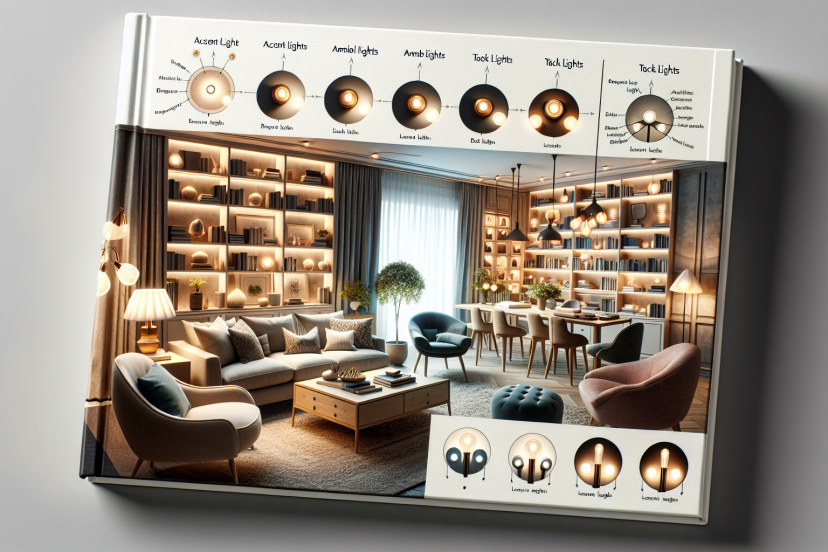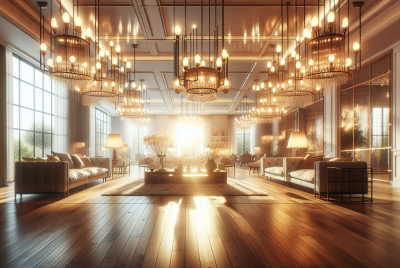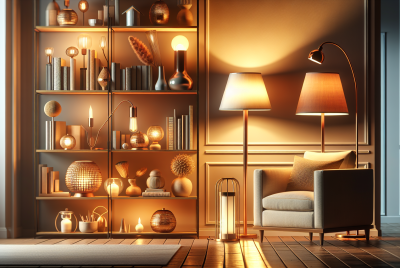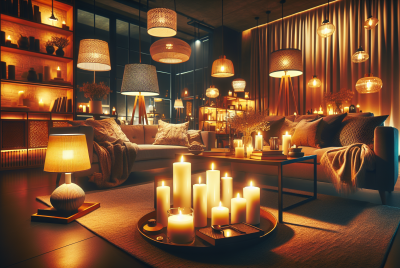Beginner’s Guide To Interior Lighting Design
Are you looking to create a warm and inviting atmosphere in your home? Look no further than the beginner’s guide to interior lighting design! Whether you’re starting from scratch or looking to revamp your current lighting setup, this guide will help you navigate the world of interior lighting design with ease. From choosing the right types of lighting fixtures to understanding the importance of layering techniques, this guide will equip you with all the knowledge you need to create a beautifully lit space that perfectly reflects your personal style and enhances the overall ambiance of your home. So, let’s get started on illuminating your living space in the most captivating and welcoming way possible!
Understanding the Basics of Interior Lighting Design
When it comes to designing a space, lighting plays a crucial role in creating the right atmosphere and enhancing the overall ambiance. It can transform a room from dull and uninspiring to warm and inviting. To effectively design the lighting scheme for your interior, it is important to understand the basics.
Different types of lighting fixtures
There are various types of lighting fixtures to choose from, each serving a different purpose. Ceiling lights, such as chandeliers and pendant lights, provide overall illumination to a room. Task lighting fixtures, like desk lamps or under-cabinet lights, are designed to provide focused light for specific activities. Accent lights, such as track lighting or wall sconces, are used to highlight objects or architectural features. Understanding the different types of lighting fixtures will help you make informed decisions when designing your interior lighting.
Understanding the role of light in interior design
Light is not just a source of illumination; it is a design element that can dramatically impact the mood and aesthetics of a space. The right lighting can make a room feel cozy and intimate or bright and energetic. It can also accentuate certain features or create visual interest. By understanding how light works and its role in interior design, you can strategically use lighting to enhance the overall look and feel of your space.
Factors to consider for effective lighting
When designing your interior lighting, there are several factors to consider to ensure effective lighting. First, consider the purpose of the space and the activities that will take place there. This will help you determine the type and intensity of light needed. Additionally, take into account the color scheme of the room and how the lighting will interact with it. Moreover, consider the size and layout of the space, as well as any architectural features that should be highlighted. By considering these factors, you can create a lighting design that is not only functional but also aesthetically pleasing.
The importance of natural light in design
Natural light is an essential element in interior design, as it not only provides illumination but also impacts the overall ambiance of a space. It can make a room feel brighter and more spacious, and it has positive effects on our mood and well-being. When designing your lighting scheme, take advantage of natural light by allowing it to enter the space through windows and skylights. Additionally, consider how natural light interacts with artificial light sources and how it affects the color temperature in the room. Using natural light effectively can greatly enhance the design of your space.
Choosing the Right Lighting Fixtures
Selecting the right lighting fixtures is crucial to achieving the desired lighting effect in your interior. There are several factors to consider when making these decisions.
Different types of light bulbs
Light bulbs come in a variety of types, each with its own set of characteristics. Incandescent bulbs produce a warm and soft light, while halogen bulbs emit a brighter and whiter light. Compact fluorescent bulbs are energy-efficient and can last longer, and LED bulbs have become increasingly popular due to their longevity and energy efficiency. Understanding the different types of light bulbs will help you choose the right one for each specific lighting fixture.
Understanding lumens and wattage
Lumens and wattage are important factors to consider when selecting light bulbs. Lumens measure the brightness of a bulb, while wattage indicates the amount of energy it consumes. When choosing bulbs, consider the desired level of brightness and the energy efficiency you want to achieve. It is also essential to ensure that the wattage of the bulb matches the fixtures’ maximum wattage to prevent overheating or electrical issues.
Choosing between warm and cool lighting
Warm lighting creates a cozy and inviting atmosphere, while cool lighting tends to be brighter and more energizing. The choice between warm and cool lighting depends on the desired mood and function of the space. For areas where relaxation is the main goal, such as bedrooms or living rooms, warm lighting can create a soothing ambiance. On the other hand, cool lighting is more suitable for spaces where tasks or activities take place, such as kitchens or home offices.
Considering the size and style of the fixture
The size and style of lighting fixtures should be carefully considered to ensure they complement the overall design of the room. A small pendant light might get lost in a large living room, while a large chandelier may overpower a small dining area. Additionally, select fixtures that match the style of the space. For example, modern fixtures may not be the best choice for a traditional-style room, and vice versa. The size and style of lighting fixtures play a significant role in the overall aesthetics of the design.
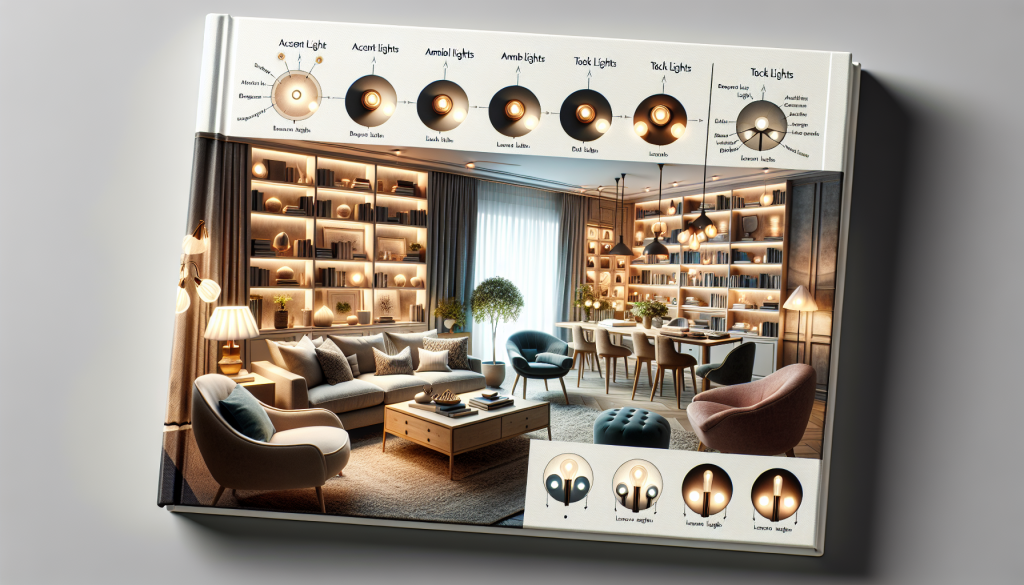
Creating Layers of Light
To achieve a balanced and well-designed lighting scheme, it is essential to create layers of light. This involves using a combination of lighting fixtures to fulfill different purposes.
Understanding the three layers of light
The three layers of light include task lighting, ambient lighting, and accent lighting. Task lighting serves a specific purpose, such as reading or cooking, and is typically provided by desk lamps, under-cabinet lights, or track lighting. Ambient lighting illuminates the entire space and sets the overall mood, often achieved through ceiling lights or recessed lighting. Accent lighting adds visual interest and highlights architectural features or decorative objects, typically achieved with spotlights or wall sconces. The combination of these three layers creates depth and dimension in the room.
Task lighting for specific purposes
Task lighting fixtures should be strategically placed to provide adequate light for specific activities. For example, in a study or office, a desk lamp would be placed on the desk to provide focused lighting for reading or working. In a kitchen, under-cabinet lighting can illuminate the countertops for food preparation. The placement of task lighting should consider the ergonomics and functionality of the space.
Ambient lighting for overall illumination
Ambient lighting is the foundation of a lighting design, as it provides general illumination for the entire space. Ceiling lights, such as chandeliers or recessed lights, are commonly used to achieve ambient lighting. The placement and intensity of ambient lighting should be carefully considered to ensure even distribution of light and to create the desired ambiance.
Accent lighting for highlighting objects or architectural features
Accent lighting serves to draw attention to specific areas, objects, or architectural features in the room. It adds visual interest and enhances the overall aesthetics of the space. Wall sconces can be used to highlight artwork, while track lighting can be directed towards a bookshelf or a display cabinet. The positioning and direction of accent lighting should be carefully planned to achieve the desired effect.
Placement and Positioning of Lighting
The placement and positioning of lighting fixtures play a crucial role in the overall effectiveness of the lighting design. Consider the following factors when positioning your fixtures.
Determining the ideal height for pendant lights and chandeliers
When hanging pendant lights or chandeliers, the height at which they are positioned is important for both functionality and aesthetics. In dining areas, a chandelier should be hung at a height that allows for comfortable conversation and does not obstruct the view across the table. In living rooms or entryways, pendant lights should be hung at a height that does not impede movement or obstruct the line of sight. The ideal height will depend on the specific dimensions and purpose of the space.
Sizing and spacing requirements for recessed lights
Recessed lights, also known as can lights or downlights, are commonly used for ambient lighting. The size and spacing of recessed lights should be appropriate for the size of the room and the desired level of illumination. Generally, larger rooms require more recessed lights, spaced evenly to ensure even distribution of light. Smaller rooms may require fewer lights, but they should still be positioned strategically to provide adequate illumination.
Avoiding shadows and glare
Shadows and glare can negatively affect the functionality and aesthetics of a space. It is important to position lighting fixtures in a way that minimizes shadows, especially in areas where tasks or activities take place, such as kitchen countertops or office desks. Glare, caused by excessive brightness, should also be avoided by using diffusers or adjustable fixtures that allow you to control the direction of light.
Using lighting to define zones or focal points
In open-concept spaces or rooms with multiple functions, lighting can be used to define different zones and create focal points. For example, in a living room, a combination of ambient lighting and accent lighting can be used to distinguish the seating area from the entertainment area. In a bedroom, a pendant light or a chandelier can be used to create a focal point above the bed. By using lighting strategically, you can enhance the functionality and aesthetics of different areas within a space.
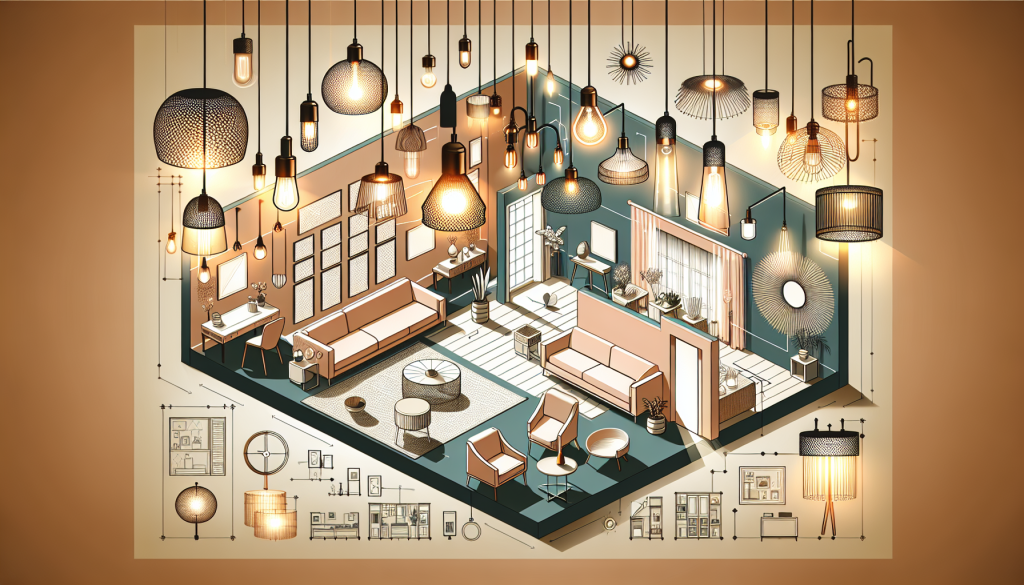
Color Temperature and Light Effects
Color temperature and light effects have a significant impact on the atmosphere and mood of a room. Understanding these concepts can help you create the desired lighting effect.
Understanding color temperature and its impact on a space
Color temperature refers to the color appearance of light, ranging from warm (yellowish) to cool (bluish). Warm light creates a cozy and intimate ambiance, while cool light tends to be brighter and more energizing. The choice of color temperature depends on the desired mood and function of the space. For areas meant for relaxation, such as bedrooms or living rooms, warmer color temperatures are often preferred. For areas meant for tasks or activities, such as kitchens or home offices, cooler color temperatures may be more suitable.
Choosing warm or cool light for different areas
Different areas of a home may benefit from different color temperatures. Bedrooms, for example, can benefit from warm lighting to create a soothing environment for rest and relaxation. Kitchens, on the other hand, may benefit from cool lighting to provide bright and focused light for cooking or food preparation. Consider the function and desired mood of each area to determine the appropriate color temperature.
Creating different moods with lighting
Lighting can be used to create different moods and atmospheres in a space. By dimming lights or using colored bulbs, you can significantly change the ambiance. For example, dimming the lights in a living room can create a cozy and intimate setting for a movie night. Using colored bulbs in a home bar or entertainment area can create a vibrant and lively atmosphere. By experimenting with different lighting effects, you can transform the mood of a room to suit different occasions.
Using dimmers and smart lighting for versatility
Dimmers and smart lighting systems add versatility to your lighting design. Dimmers allow you to adjust the brightness of a light fixture, giving you control over the ambiance of the space. Smart lighting systems, controlled through a mobile app or voice command, offer even more flexibility, allowing you to change the color temperature, brightness, and even the pattern of the lights. These technologies provide convenience and allow you to customize the lighting to suit various activities and moods.
Importance of Energy Efficiency
In addition to aesthetics and functionality, energy efficiency is an important consideration when designing your lighting scheme. There are several ways to incorporate energy-efficient lighting into your design.
Choosing energy-efficient light bulbs
Energy-efficient light bulbs, such as LED or compact fluorescent bulbs, consume less energy compared to traditional incandescent bulbs. LED bulbs, in particular, have a significantly longer lifespan and consume very little energy, making them a cost-effective choice in the long run. When selecting light bulbs, look for the Energy Star label, which indicates high energy efficiency.
Understanding energy-saving lighting options
In addition to using energy-efficient light bulbs, there are other energy-saving lighting options to consider. Motion sensors can be installed in areas where lighting is not needed constantly, such as hallways or bathrooms, to ensure that lights are only on when necessary. Timers can be used to automatically turn off lights at a specific time, preventing energy waste. By utilizing these energy-saving options, you can reduce your energy consumption and contribute to a more sustainable environment.
Using timers and sensors for efficient usage
Timers and sensors are valuable tools for efficient lighting usage. Timers can be used to control the time duration that lights are on. For example, outdoor lights can be set to turn off automatically at sunrise or after a specific number of hours. Sensors, such as motion sensors or occupancy sensors, can detect movement and turn on/off lights accordingly. These technologies ensure that lights are only used when needed, saving energy and reducing utility costs.
Considering the environmental impact of lighting choices
It is important to consider the environmental impact of your lighting choices. Traditional incandescent bulbs contribute to high energy consumption and greenhouse gas emissions. By opting for energy-efficient bulbs and sustainable lighting practices, you can significantly reduce the carbon footprint associated with lighting. Additionally, consider recycling old or damaged light bulbs, as they may contain hazardous materials that require proper disposal.
Lighting Design for Different Rooms
Each room in your home has specific lighting needs and considerations. Here are some tips for designing the lighting in different rooms.
Living room lighting ideas
The living room is a space meant for relaxation and socialization. A combination of ambient, accent, and task lighting creates a balanced lighting scheme. Ceiling lights provide overall illumination, while floor lamps or table lamps can be used for task lighting. Wall sconces or spotlights can be employed to highlight artwork or architectural features. Dimmers can be used to adjust the brightness and create different moods.
Bedroom lighting tips and tricks
In the bedroom, creating a soothing and cozy environment is key. A combination of soft ambient lighting and task lighting is desirable. Ceiling lights or wall-mounted fixtures can provide ambient lighting, while bedside table lamps or wall sconces can be used for task lighting. Consider using dimmers to adjust the brightness and create a relaxing atmosphere for bedtime.
Kitchen lighting solutions
The kitchen is a functional space that requires bright and focused lighting. Ambient lighting can be achieved through ceiling lights or recessed lights, providing overall illumination. Task lighting is essential for specific areas, such as countertops or the stovetop. Under-cabinet lighting can be used to illuminate the workspace. Consider using cool lighting to provide bright and energizing light for cooking and food preparation.
Bathroom lighting considerations
In the bathroom, a combination of ambient and task lighting is necessary. Ceiling lights or recessed lights can provide overall illumination, while vanity lights can be used for task lighting. It is important to ensure that the lighting around the vanity mirror is even and free from shadows, as this is where grooming tasks take place. Consider using LED bulbs for vanity lights, as they provide bright and clear light ideal for applying makeup or shaving.
Lighting Design Strategies for Small Spaces
In small spaces, lighting plays a crucial role in maximizing the perceived size and enhancing the overall ambiance. Here are some strategies for designing lighting in small spaces.
Utilizing mirrors to enhance lighting
Mirrors can be used strategically to enhance lighting in small spaces. Placing a mirror opposite a window or a light source can help reflect and amplify natural or artificial light, making the room feel brighter and more spacious. Additionally, consider using mirrored furniture or accessories to further enhance the reflection of light.
Using light paint colors to maximize light
Light paint colors can make a small space appear larger by reflecting light and creating a sense of openness. Light and neutral shades, such as whites, pastels, or light grays, are ideal choices for small spaces. Avoid dark or intense colors, as they tend to absorb light and make the room feel smaller.
Optimizing natural light sources
In small spaces, natural light sources should be optimized to the fullest extent. Keep windows unobstructed to allow maximum light penetration. Consider using sheer or light-filtering window treatments that provide privacy while still allowing natural light to enter the space. Additionally, avoid placing furniture or other objects that may cast shadows and hinder the flow of natural light.
Choosing space-saving lighting fixtures
In small spaces, it is important to choose lighting fixtures that are proportionate to the size of the room. Opt for slim and compact fixtures that do not take up too much visual space. Wall sconces or pendant lights can be used instead of floor or table lamps to save floor space. Consider recessed lights or track lighting as they provide functional lighting without occupying additional space.
Adding Style and Personality with Lighting
Lighting is not just about functionality; it is also an opportunity to add style and personality to your interior design. Here are some ideas for incorporating lighting as a design element.
Incorporating decorative lighting elements
Decorative lighting elements, such as chandeliers, pendant lights, or unique lamp designs, can serve as focal points and art pieces in your space. Opt for fixtures that complement the overall style and theme of the room. For example, a crystal chandelier adds elegance to a formal dining room, while a sleek and modern pendant light enhances a contemporary living room.
Choosing lighting fixtures that complement the overall style
The style of lighting fixtures should harmonize with the overall style of the room. For a traditional space, consider fixtures with ornate details and warm finishes, such as antique brass or bronze. For a modern or minimalist space, opt for fixtures with clean lines and a sleek finish, such as brushed nickel or chrome. Choose fixtures that reflect your personal style and contribute to the overall design aesthetic.
Creating focal points with unique lighting installations
Unique lighting installations can create dramatic focal points and add visual interest to a room. Consider incorporating statement-making fixtures, such as oversized pendant lights, cascading chandeliers, or artistic light sculptures. These installations can become conversation pieces and truly elevate the design of the space.
Using lighting as an art form
Lighting can be used as an art form to create mesmerizing visual effects and transform a space. Consider using colored LED lights to wash a wall with vibrant hues or to create a dynamic light show. Install recessed lighting along architectural features, such as an exposed brick wall or a vaulted ceiling, to highlight their beauty. By thinking of lighting as an artistic element, you can unleash your creativity and create breathtaking effects.
Common Lighting Design Mistakes to Avoid
As with any design process, there are common mistakes that can hinder the success of your lighting design. Be mindful of the following mistakes and take steps to avoid them.
Insufficient lighting for a space
One of the most common lighting design mistakes is not providing enough light for a space. Insufficient lighting can make a room feel gloomy, less functional, and visually unappealing. It is important to assess the lighting needs of each space and incorporate the appropriate fixtures to ensure adequate illumination. Consider layering different types of lighting to fulfill different purposes and to create a balanced lighting scheme.
Overlooking the importance of layering
Layering is a fundamental principle in lighting design, yet it is often overlooked. Layering involves using a combination of ambient, task, and accent lighting to create depth and dimension in a room. Neglecting to incorporate all three layers can result in a flat and uninspiring lighting scheme. Remember to consider the function and aesthetics of the space and use different types of lighting fixtures strategically to achieve a well-balanced design.
Using incorrect color temperature or wattage
Using incorrect color temperature or wattage can significantly affect the mood and functionality of a space. Color temperature that is too cool or too warm can create an uncomfortable or unflattering ambiance. Ensure that the color temperature aligns with the desired mood and purpose of the space. Additionally, using light bulbs with wattage that exceeds the maximum rating of the fixtures can lead to illumination issues and potentially cause electrical problems. Always check the wattage compatibility of your fixtures and bulbs.
Neglecting the role of lighting in enhancing décor
Lighting is not just about illumination; it is an integral part of the overall design scheme. Neglecting the role of lighting in enhancing the décor can result in a lackluster and incomplete design. Consider how lighting fixtures can complement the style and theme of the room. Choose fixtures with interesting shapes, finishes, or details that add visual interest and contribute to the overall aesthetics of the space.
In conclusion, understanding the basics of interior lighting design is essential for creating a well-designed and functional space. Consider the different types of lighting fixtures, the role of light in interior design, and the factors to consider for effective lighting. Pay attention to choosing the right lighting fixtures, creating layers of light, positioning and placing lighting fixtures correctly, and utilizing color temperature and light effects. Additionally, prioritize energy efficiency, design lighting for different rooms and small spaces, add style and personality with lighting, and avoid common lighting design mistakes. By following these guidelines, you can achieve a carefully curated lighting design that enhances the overall ambiance and aesthetics of your interior space.

